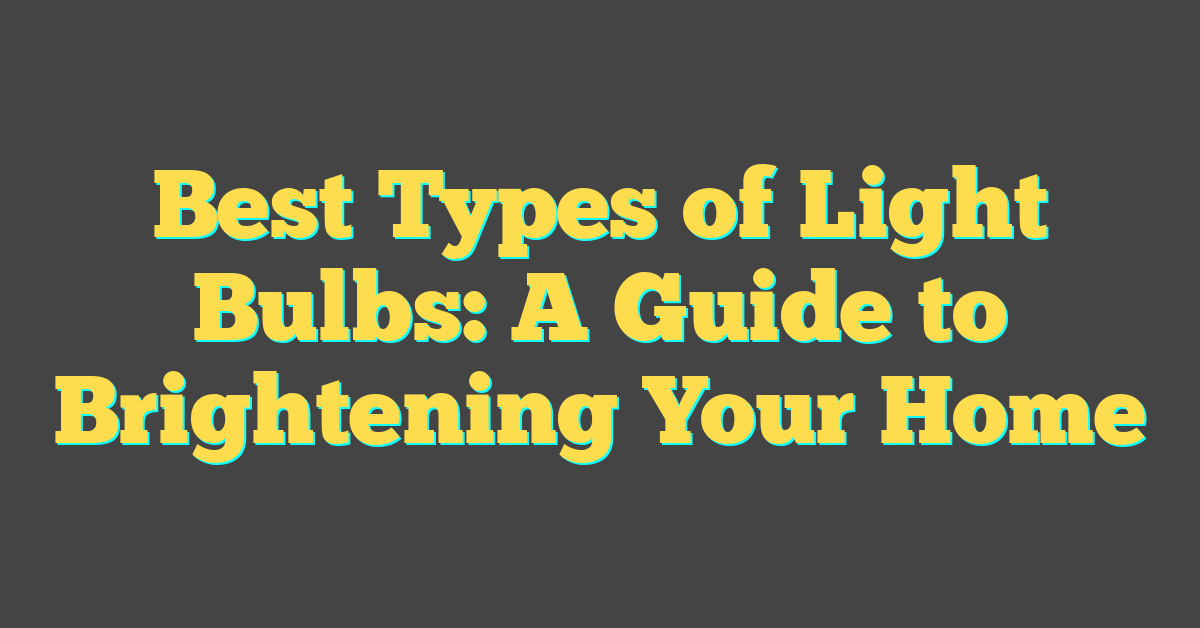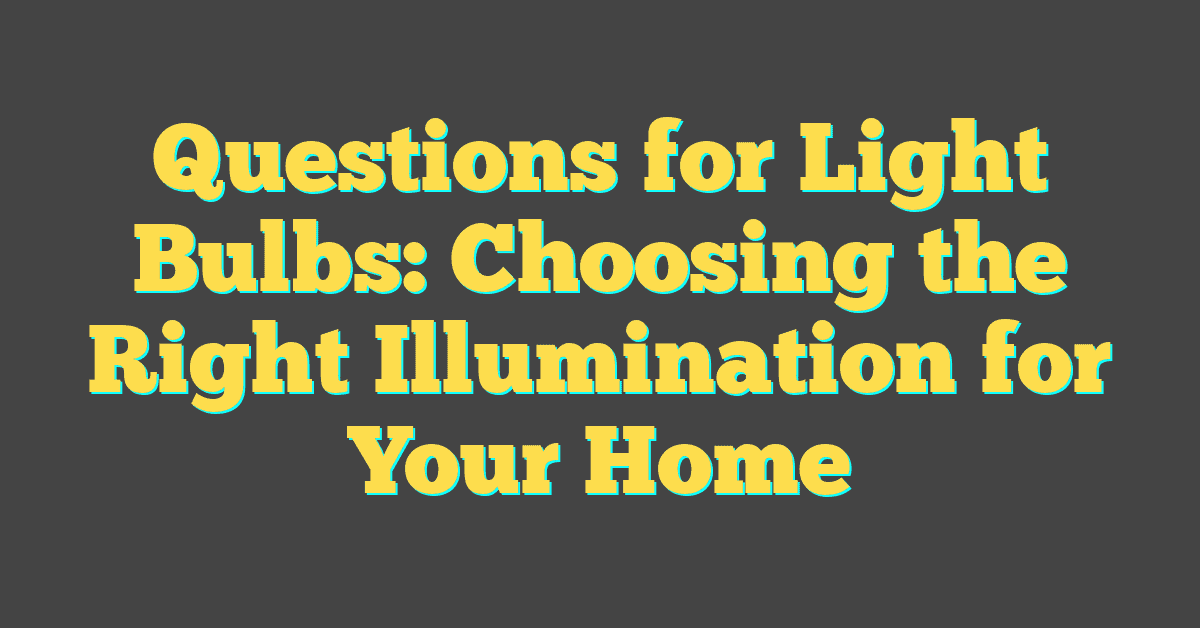When you’re navigating the world of light bulbs, it’s not just wattage and brightness you have to consider, but also the type of connection that fits your fixtures. Among the various options, light bulbs with 2 prongs are a distinct category that stands out for its unique base design, typically known as a bi-pin or twist-lock base. These bulbs are designed for specific types of lighting fixtures and offer a secure fit with a simple push-and-turn installation method.
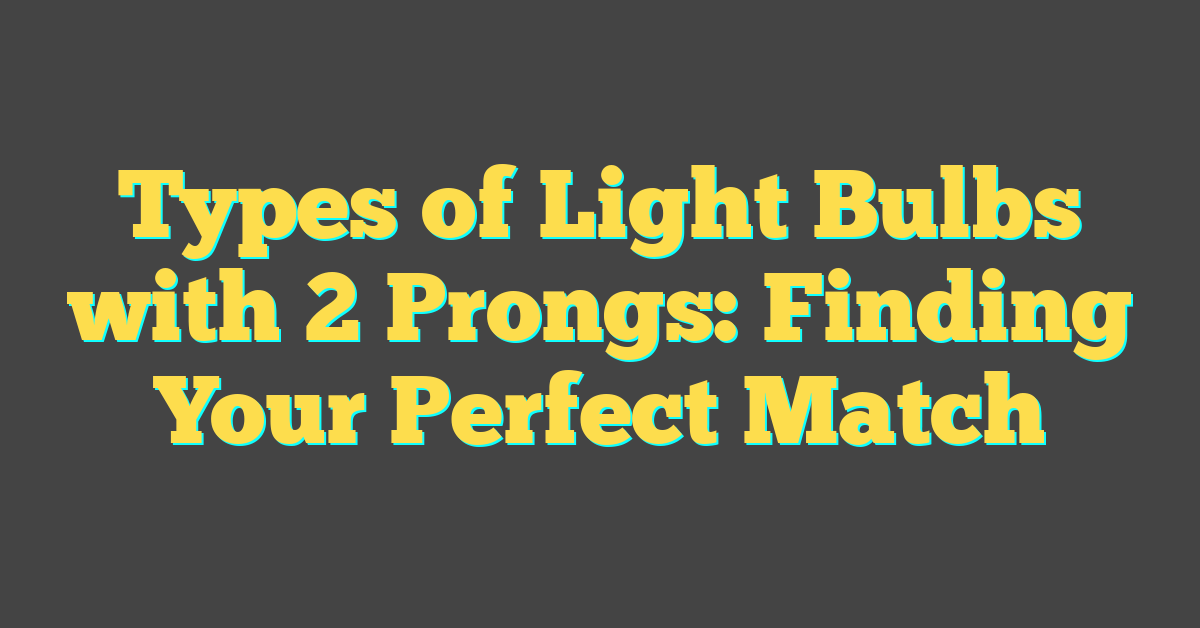
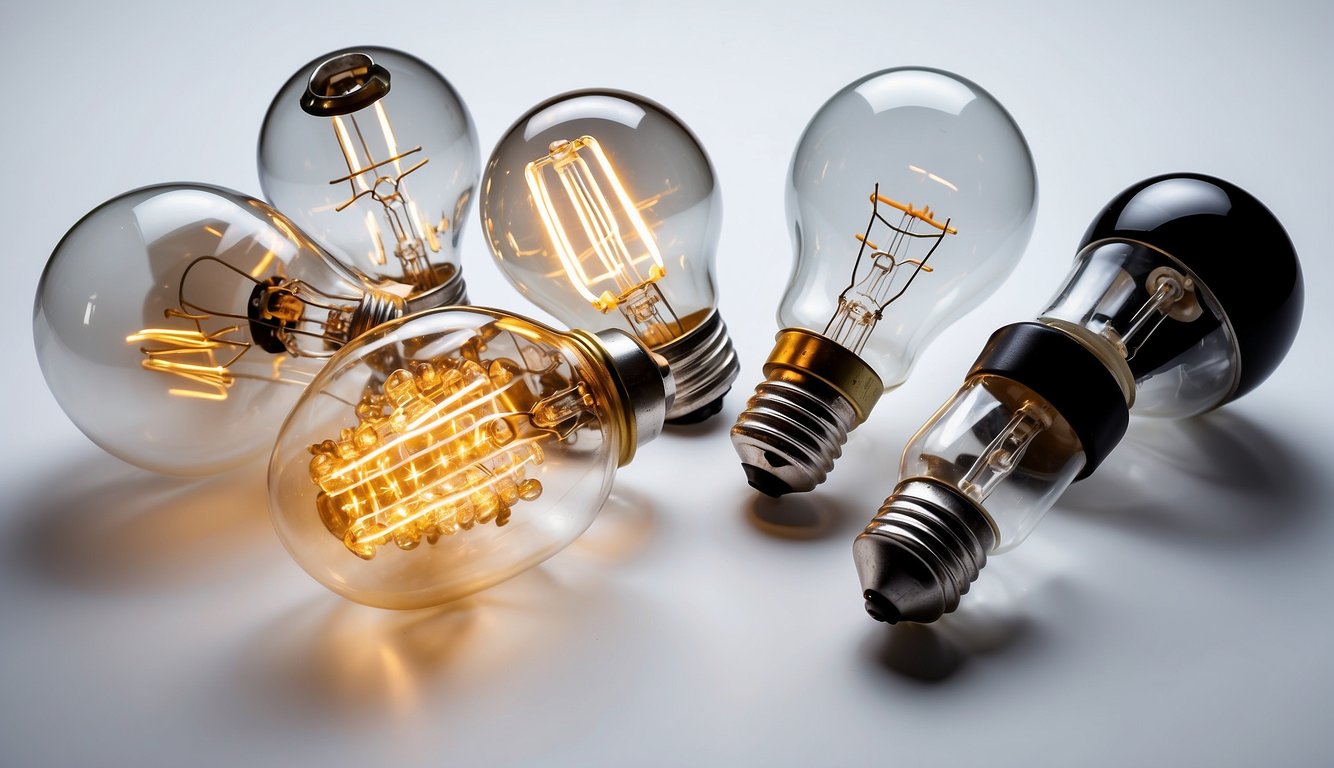
Understanding the types and applications of 2-prong light bulbs is important so you can make informed decisions whether you’re replacing bulbs at home or upgrading lighting in a commercial space. These bulbs come in a variety of sizes and styles, each serving a particular purpose or aesthetic preference. From the energy-efficient LED and compact fluorescent (CFL) bulbs to the more traditional halogen options, 2-prong light bulbs cater to a range of lighting needs and preferences.
Key Takeaways
- 2-prong light bulbs are characterized by their unique base design for secure fixture connection.
- They come in various types, including LEDs, CFLs, and halogens, to suit different lighting requirements.
- Proper identification and application ensure optimal performance and energy efficiency for these bulbs.
Understanding Light Bulbs with 2 Prongs
https://www.youtube.com/watch?v=Zq9X6rVRIOY&embed=true
When you are searching for the right light bulb for your fixture, you might come across bulbs with two metal pins at the base. These are commonly referred to as “2 prong” bulbs and are designed for certain types of lighting fixtures.
Types of 2 Prong Bulbs:
- Bi-pin: These bulbs have two pins straight across from each other and are often used in under-cabinet lighting or desk lamps.
- Gu10: Twist and lock base design which is frequently used in track lighting.
| Base Type | Common Use |
|---|---|
| Bi-pin | Under-cabinet |
| Gu10 | Track lighting |
2 prong bulbs can readily be identified by the distance between the pins and their shape. For instance, a G4 base has a 4mm pin spread, while GU10 has a twist-lock mechanism.
When choosing a light bulb with two prongs, it’s vital to know your fitting or cap type. This can prevent a mismatch with your existing fixture. Keep in mind that 2 prong bulbs are often halogen or LED, both options providing efficient, bright lighting for various needs.
Here’s a breakdown of pin types to assist you:
- G4, GU4: Typically low voltage, suitable for small lamps.
- G5, GU5.3, GX5.3: Generally found in spotlight and downlight applications.
- GU10: Known for track and recessed lighting.
For detailed information on the differences between two pin bulbs, consider the following Quick Guide to Light Bulbs with Two Pins.
Remember, ensuring compatibility with your fixture is crucial for performance and safety. Check your lighting fixture’s requirements before purchasing to ensure a perfect fit!
Types of 2-Prong Light Bulbs
https://www.youtube.com/watch?v=R4KqKJv1-1M&embed=true
When you’re looking to replace or upgrade your 2-prong light bulbs, you have several options to consider. Each type has its own unique benefits that might suit your needs in different scenarios.
LED Bulbs
LED bulbs with two prongs are known for their energy efficiency and long lifespan. These bulbs can provide bright, clear light while using significantly less power compared to other types. If you’re looking for a cost-effective and eco-friendly option, LED 2-prong light bulbs might just be the right choice for you.
Halogen Bulbs
Halogen bulbs, another category of 2-prong bulbs, offer a crisp, white light and are often used in workspaces and for accent lighting. They reach full brightness instantly, giving you clear visibility the moment you turn them on. However, they tend to have a shorter lifespan and are less energy efficient when compared to LED bulbs.
CFL Bulbs
« Light Bulb Camera Pros and Cons: Unveiling the Hidden Truths
Tips for Changing Light Bulb: A Quick and Safe Guide »
CFL (Compact Fluorescent Lamp) bulbs with two prongs are a common choice if you seek a balance between efficiency and cost. CFLs use a fraction of the energy of an incandescent light and have a longer life. Be mindful that they contain trace amounts of mercury, so proper disposal is important.
Incandescent Light Bulb
Finally, the incandescent light bulb with two prongs is a traditional option that provides a warm, amber glow. Though they are less energy-efficient and have a shorter operational life than other bulb types, their classic appeal is unmatched for creating a cozy atmosphere.
Identifying 2-Prong Light Bulb Bases
https://www.youtube.com/watch?v=BIiANEstIX4&embed=true
When you’re replacing or installing light bulbs with two prongs, it’s essential to recognize the specific base type your fixture requires. The correct base ensures a proper connection to your light fixture and optimal lighting performance.
Bi-Pin Base
Bi-pin bases are characterized by two parallel pins protruding from the base of the bulb. These are commonly found in a variety of lighting applications such as under-cabinet lighting, certain types of recessed lighting, and track lighting. The spacing of the pins can vary, which impacts the compatibility with your fixture. The diameter of these pins typically plays a role in the naming convention for these bulbs. For example, a G4 base means the pins are 4 millimeters apart.
You’ll encounter a wide range of bi-pin base types, each indicated by a different letter and number combination. Identifying the correct one often requires measuring the distance between the pins. One notable example is the G9 base, which has a pin spread of 9 millimeters and is frequently used in desk lamps, pendants, and wall fixtures. For visual assistance, you can refer to a light bulb base chart.
Wedge Base
Wedge bases, on the other hand, integrate two thin, wedge-shaped prongs that taper toward the end and are inserted into corresponding slots. These are generally used in smaller, specialty lighting such as automotive interior lights, landscape lights, and some types of dashboard lights.
With these bulbs, the prong’s diameter can range in size, affecting the bulb’s stability and connectivity. Unlike bi-pin bases that require you to measure the distance between pins, identifying wedge base bulbs is often a matter of looking at the shape and size of the prong. If you’re unsure of the bulb type or size needed for your fixture, consulting your fixture’s user manual or examining the current bulb can provide clarity.
Applications and Uses
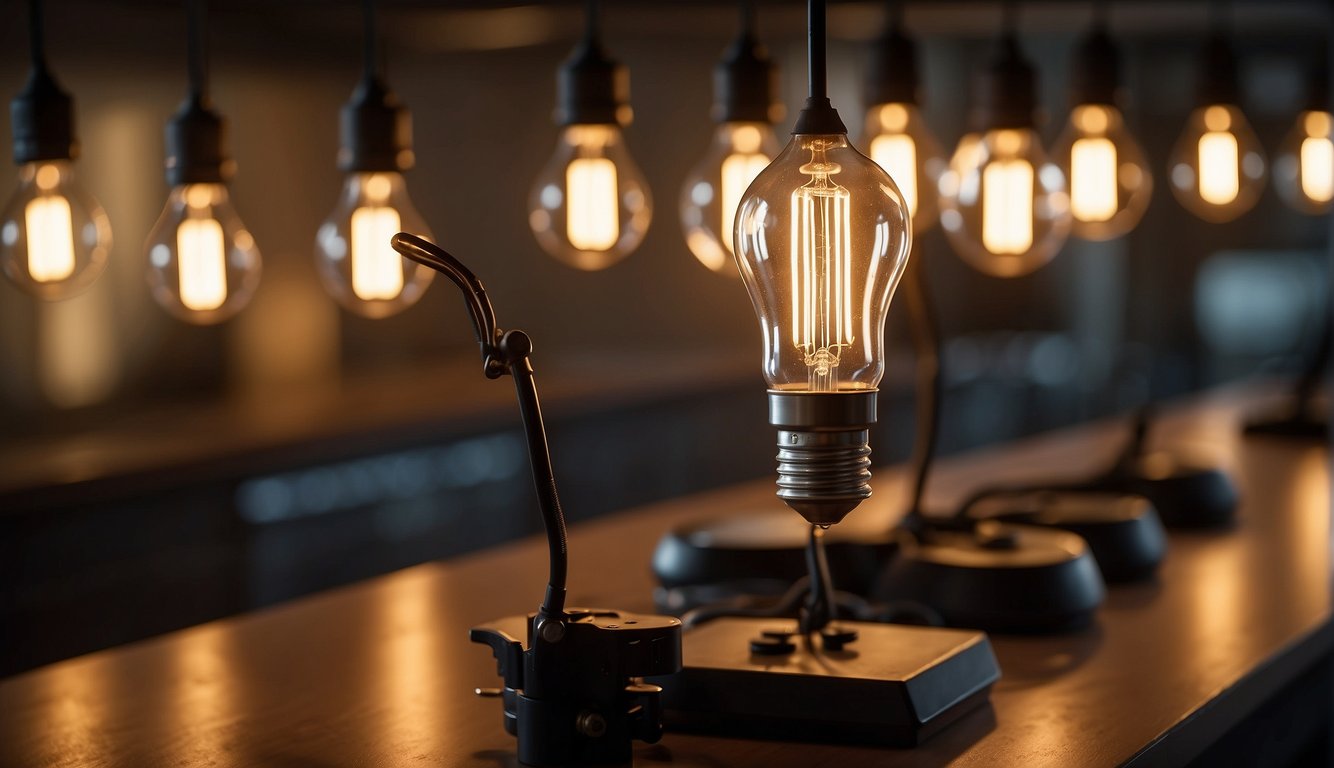
When you’re considering light bulbs with two prongs for your home or office, it’s important to know where these types of bulbs can be effectively utilized. Their specific design makes them suitable for certain applications that other bulbs might not fit.
Appliances
In your appliances, these two-pronged bulbs often serve as a compact lighting solution. For example, they’re used inside your microwave to provide visibility while cooking or in your refrigerator to light up the interior when you’re searching for a snack. These bulbs are also found in ovens, where they can withstand high temperatures.
Track Lighting
For your track lighting needs, two-pronged light bulbs are a popular choice for their directional light. They focus the beam tightly to illuminate artworks, highlight architectural features, or offer task lighting in a kitchen workspace. These bulbs are efficient for creating ambiance in a room or spotlighting a specific area.
Replacing 2-Prong Bulbs
https://www.youtube.com/watch?v=PLW-2oteW3A&embed=true
When your 2-prong halogen light bulb needs replacing, you’ll notice its bi-pin design. This refers to the two metal prongs at the base that insert into the socket. To replace such a bulb, follow these steps carefully to ensure a proper fit and to maintain safety.
- Ensure Safety: First, turn off the power to the light fixture to prevent electrical shock. Allow the bulb to cool down if it was recently used.
- Removal: Gently grasp the bulb without applying too much pressure. Rock it slightly back and forth while pulling it away from the socket.
- Identify Bulb Type: Take note of the pin spacing (important for compatibility) — common types are labeled G4 or G9, indicating the distance between the prongs in millimeters.
| Bulb Type | Pin Spacing |
|---|---|
| G4 | 4mm |
| G9 | 9mm |
- Purchase New Bulb: When buying a replacement, match the voltage and wattage to your previous bulb. The pin spacing must also be identical to fit the socket.
- Installation: Align the prongs with the socket and gently push the new bulb in until it is securely in place.
By following these instructions, you’ll have a functional light fixture once again. If you’re unsure about any steps, don’t hesitate to consult a professional or look for instructional videos on replacing a 2-prong light bulb for visual guidance. Remember, proper handling and installation will prolong the life of your new bulb.
Energy Efficiency Comparisons
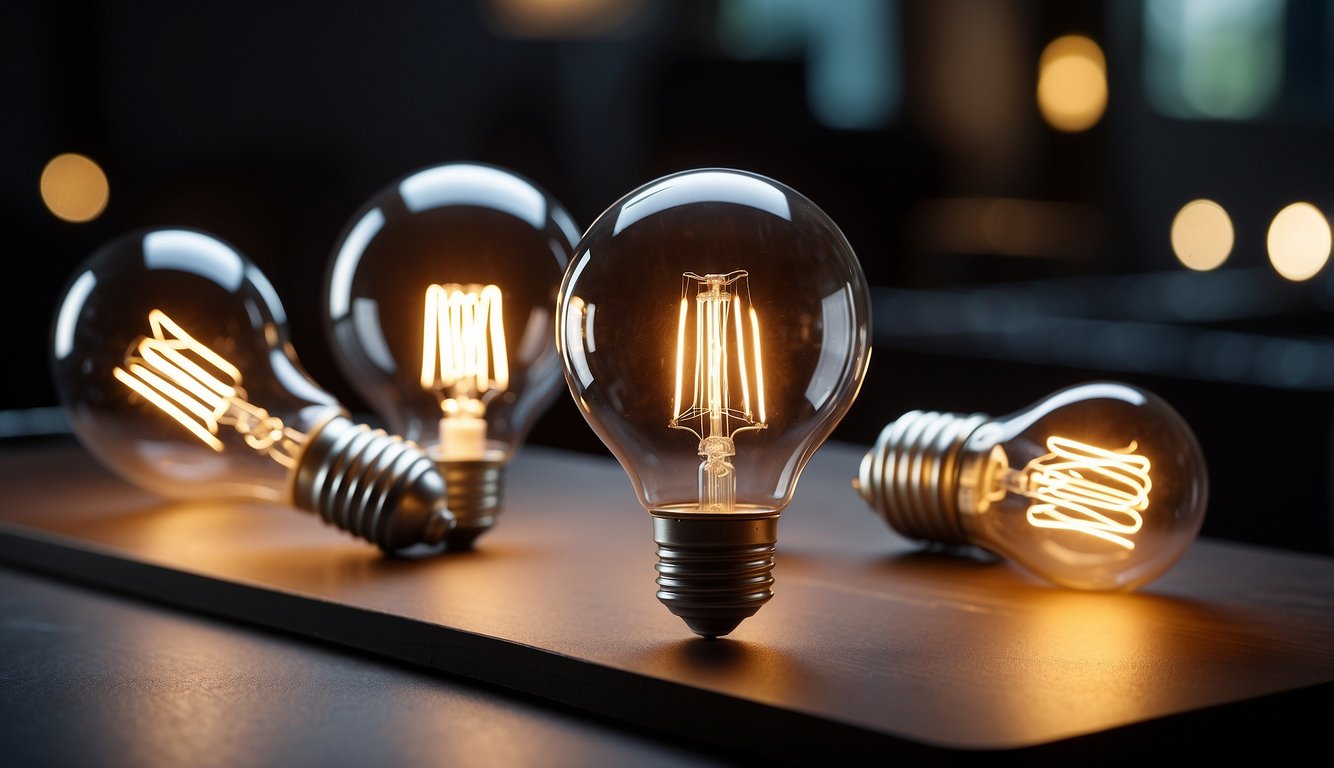
When considering a new light bulb with 2 prongs, your choice could significantly impact your energy consumption. This section will help you understand how different types of bulbs compare in terms of energy efficiency.
LED vs Halogen
LEDs are known for their high energy efficiency, using about 85-90% less energy than halogen bulbs. If you’re looking for a 2-prong bulb option that saves on your electricity bill, LEDs should be your go-to. For instance, an LED might use only 10 watts of power to offer the same light output that a 50-watt halogen bulb would provide, translating to direct energy savings for you.
LED vs CFL
When compared to CFLs (Compact Fluorescent Lamps), LEDs still come out on top, being slightly more energy efficient. While a typical CFL might convert about 70-80% of its energy into light, an LED can push that to around 90%. Moreover, LED lamps tend to have a longer lifespan than CFLs, which means less frequent replacements and additional savings over time.
CFL vs Halogen
CFL bulbs offer a significant energy-saving advantage over halogen bulbs, using about 70-80% less energy. While they may not light up as quickly as halogens when you flick the switch, their lower energy consumption makes CFLs a good choice if you’re seeking efficiency and affordability with 2-prong lighting solutions.
Aesthetic and Lighting Quality
When choosing a light bulb with 2 prongs, you should consider how it affects the overall look and feel of your space. Factors like color accuracy, brightness, and the shade of white light can significantly impact the aesthetics and lighting quality in any room.
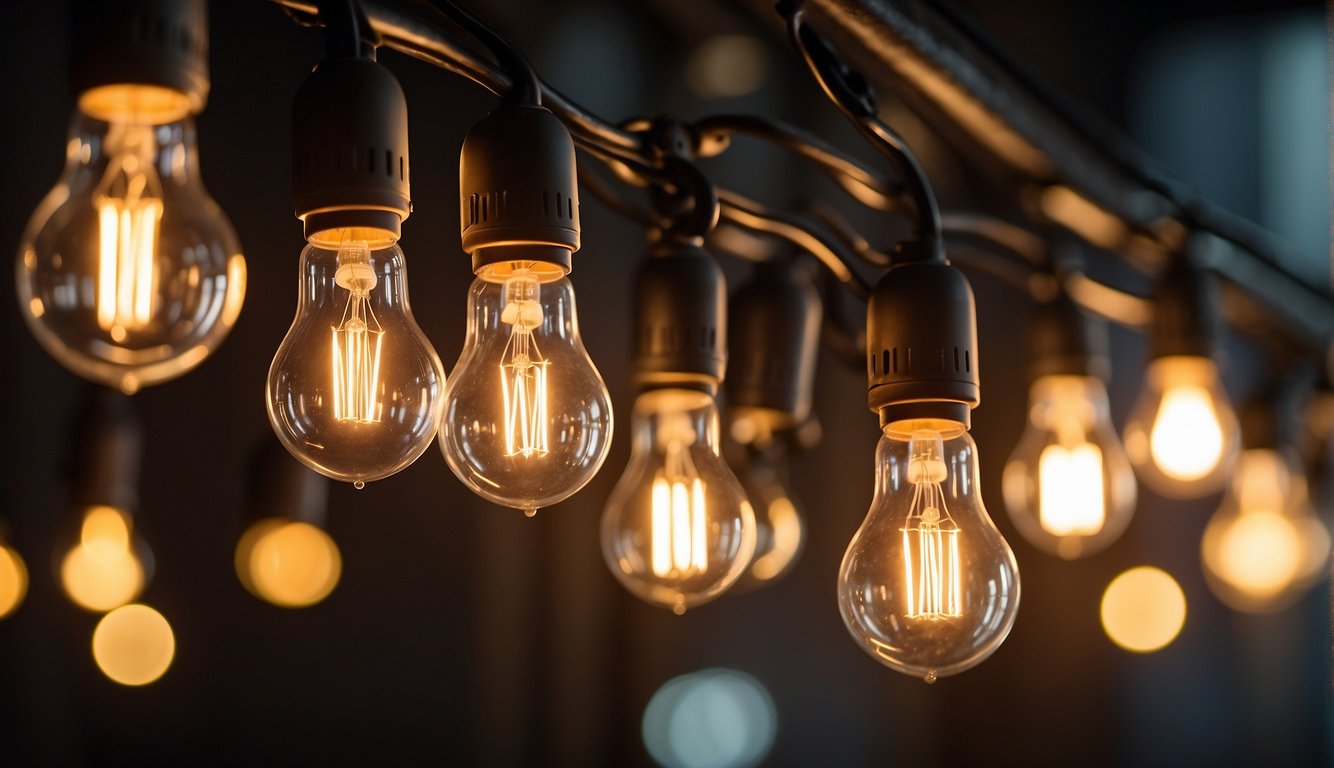
Color Rendering Index (CRI)
The Color Rendering Index (CRI) measures how accurately a light source displays colors in comparison to natural light. For bulbs with 2 prongs, specifically LEDs, you’ll want a CRI rating closer to 100 for the most vivid and natural hues.
Brightness Levels
Brightness is measured in lumens. The higher the lumens, the brighter the light. Two-prong light bulbs, like CFLs or LEDs, come in a range of brightness levels. You’ll typically find comfortable indoor brightness between 800 to 1100 lumens.
Color Temperature
The color temperature is expressed in Kelvins (K) and describes the warmth or coolness of a bulb’s light. Two-prong bulbs can range from warm white (2700K) to daylight (6500K), with LEDs offering a wider spectrum to suit your specific taste in lighting ambience.
2-Prong Bulb Shapes and Sizes
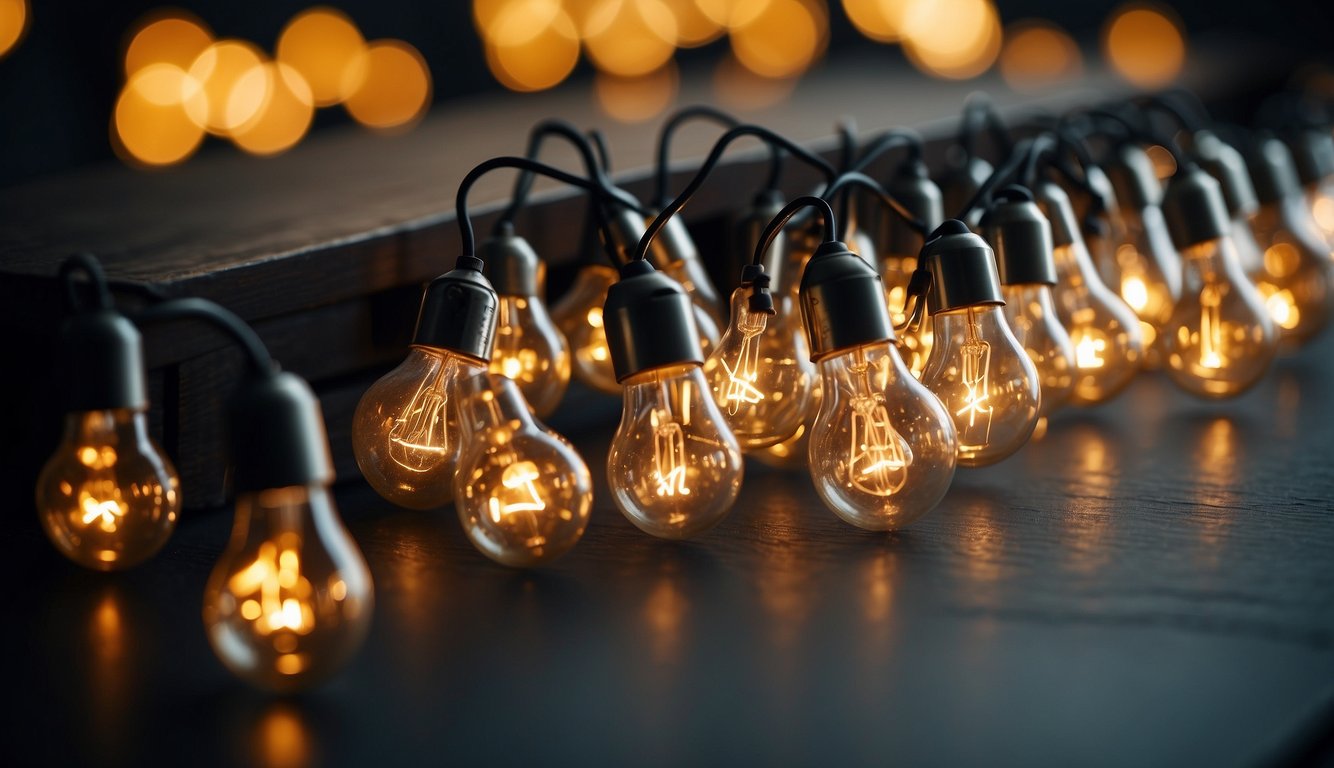
When you’re looking to replace or install 2-prong light bulbs, it’s important to know the different shapes and sizes available. Each shape has its own ideal use and setting where it shines the brightest, both literally and figuratively.
A19 Bulbs
The A19 bulb is a standard shape that you’re likely familiar with. As a medium-sized bulb, it’s well-suited for a variety of household applications. The “A” in A19 indicates the shape (arbitrary) and “19” represents the diameter in eighths of an inch, making the A19 bulb about 2.4 inches in diameter.
Candle Bulbs
Candle bulbs, also referred to as Candelabra bulbs, typically have a slender shape that tapers towards the top, mimicking the look of a flame. These bulbs are perfect for decorative fixtures, chandeliers, and wall sconces, adding a touch of elegance to your space.
Globe Bulbs
Globe bulbs are distinguished by their round, spherical shape. They provide a wide, even light distribution, lending themselves well to bathroom vanities and pendant lights where a softer glow is needed. The globe’s shape is both functional and stylish, working well in modern decor schemes.
Safety and Handling

Properly managing light bulbs with two prongs is essential for both safety and longevity, especially when dealing with sensitive components like quartz and filaments. Your understanding of these factors will help avoid potential hazards and maintain the bulbs’ functionality.
Quartz Halogen Bulbs
When handling quartz halogen bulbs, remember that they operate at high temperatures and pressures. It’s crucial to avoid touching the quartz glass with bare hands; oils from your skin can lead to hot spots on the glass, potentially causing the bulb to fail prematurely. Always use a clean, lint-free cloth when installing or replacing these bulbs. As for disposal, treat them with care and follow local regulations as the quartz and internal halogen gas can be harmful to the environment if not disposed of correctly.
Filament Fragility
The filament in a two-prong light bulb is delicate and can break if the bulb is shaken or struck. To ensure the longevity of your bulb, install it by holding the base of the bulb, and avoid touching the glass. When a bulb burns out, allow it to cool before removal to prevent burns or damage. Dispose of the used bulb carefully to prevent the filament from shattering and causing potential injury or damage.
Product Packaging and Disposal
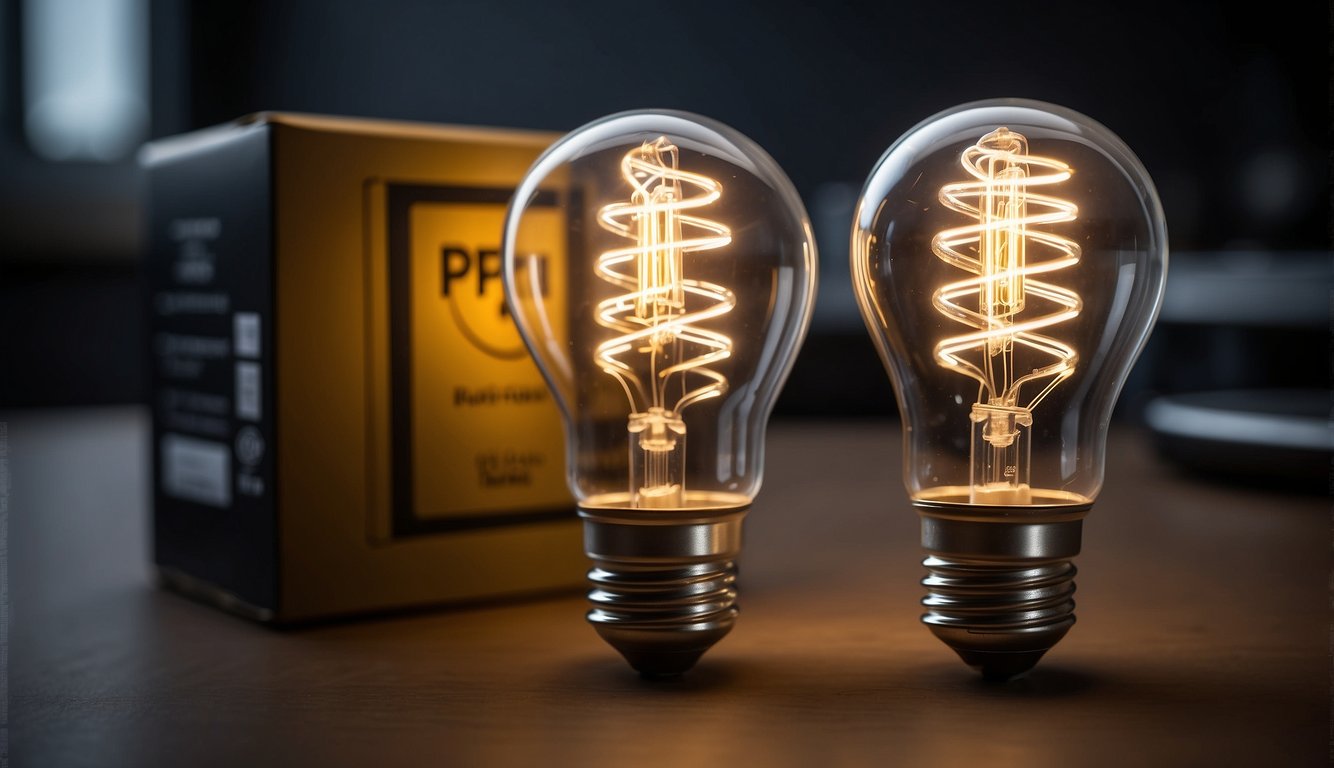
When you purchase light bulbs with two prongs, they typically come in different types of packaging designed to protect them from damage. You’ll find them housed in cardboard boxes, plastic blister packs, or sometimes encased in protective foam.
Unpacking Your Bulbs
- Carefully remove your bulbs, avoiding any unnecessary force.
- Keep all packaging for reuse or recycling.
Disposal of Packaging
- Cardboard can be flattened and recycled.
- Plastic blister packs should be checked for recycling symbols and disposed of accordingly.
- Foam inserts are often not recyclable, so check with local waste management.
Recycling Light Bulbs
Recycling methods for two-prong light bulbs vary depending on the type. Here’s a quick guide:
LED: Some local recycling programs accept LEDs.
Halogen: These can usually be disposed of with regular trash, but always double-check.
Fluorescent: These contain mercury and need special handling. Your local waste management may have designated drop-off areas.
Disposing Broken Bulbs
- If a bulb breaks, place the pieces in a sealed bag or container.
- Wash your hands thoroughly after handling broken pieces.
Disposal Tips
- Never dispose of light bulbs in your regular recycling bin unless directed by your local authority.
- Use designated facilities for bulb types that contain hazardous materials.
For your safety and the environment’s well-being, always follow local guidelines for disposal and recycling. If in doubt, a quick call to your local waste management or a visit to their website will provide you with all the necessary information.

